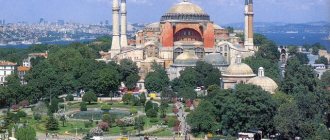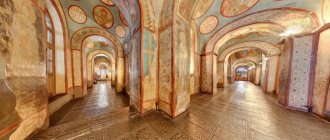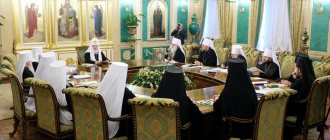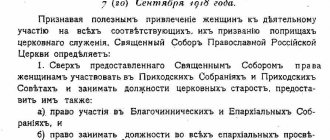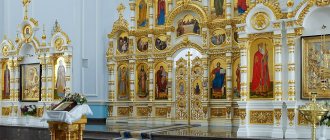| Second Ecumenical Council. Fresco from the 16th century, Sucevita Monastery, Romania. |
The Second Ecumenical Council
was convened in 381 in Constantinople under the holy emperor Theodosius the Great Commemoration May 22 and the memory of the holy fathers of the six Ecumenical Councils
- On the map: Yandex.Map, Google map (no exact coordinates)
The Council was convened against the false teaching of the former Arian bishop of Constantinople, Macedonius, who rejected the Divinity of the third Person of the Holy Trinity, the Holy Spirit. He taught that the Holy Spirit is not God, and called Him a creature or created force and, moreover, serving God the Father and God the Son, similar to Angels.
150 bishops were present at the Council.
The confession of faith approved at the Roman Council was proposed for the consideration of the holy fathers, which Saint Pope Damasus sent to Bishop Paulinus of Antioch. Having read the scroll, the holy fathers, rejecting the false teaching of Macedonius, unanimously affirmed the apostolic teaching that the Holy Spirit is not a service being, but the Life-Giving Lord, proceeding from the Father, worshiped and glorified with the Father and the Son. To refute other heresies - Eunomians, Arians and Semi-Arians - the holy fathers confirmed the Nicene Creed.
The Symbol adopted by the First Ecumenical Council did not speak of the Divine dignity of the Holy Spirit, for there was no Doukhobor heresy at that time. Therefore, the holy fathers of the Second Ecumenical Council added 8, 9, 10, 11 and 12 members to the Nicene Symbol, i.e., they finally formulated and approved the Nicene-Constantinopolitan Symbol, which is still professed by the entire Orthodox Church.
The Second Ecumenical Council, in addition, established the forms of church court, determined to accept into communion through the Sacrament of Confirmation repentant heretics who were baptized in the Name of the Holy Trinity, and to accept those baptized by single immersion as pagans.
Saint Gregory the Theologian, Patriarch of Constantinople, in his speech at the Council gave the following statement of the Orthodox faith:
“The Beginningless Beginning and the Existing One with the Beginning are One God. But beginninglessness or unbornness is not the nature of the Beginningless One. For every nature is determined not by what it is not, but by what it is: it is a position, and not a negation of what exists. And the Beginning, in that it is the beginning is not separated from the Beginningless, for for Him to be the beginning does not constitute nature, just as for the first to be beginningless; because this only relates to nature, and is not nature itself. And the Existing One with the Beginning and the Beginning is nothing other than the same as They. The Name of the Beginningless is the Father, the Beginning is the Son, the Existing One with the Beginning is the Holy Spirit; and the nature in the Three is one - God. Unity is the Father, from Whom and to Whom they are raised, not merging, but co-abiding with Him, and not separated from each other by time, desire, or power.”
II Ecumenical Council
The Pravoslavie.Ru website continues to publish fragments of a new book by church historian and canonist Archpriest Vladislav Tsypin, “History of Pre-Christian and Christian Europe.”
Second Ecumenical Council. Dionysius. Ferapontov Monastery, Cathedral of the Nativity of the Virgin The Imperial Sacra on the convening of the council in Constantinople, the text of which has not survived, was published by the holy emperor Theodosius the Great in the spring of 381. The bishops of the eastern provinces over which he ruled were invited to the council. Gratian ruled in the west of the empire, and Theodosius’s sole jurisdiction did not extend to the western provinces. 150 bishops gathered at the council. First, the leaders of the Orthodox communities arrived from Syria, Asia and Thrace; later, when the conciliar acts had already begun, they were joined by bishops who arrived from Egypt, led by Timothy of Alexandria, as well as from Macedonia, among whom Ascholius of Thessaloniki took precedence. Among the participants of the council were St. Cyril, who occupied the See of Jerusalem from 350, the successor of Basil the Great in the See of Caesarea, Elladius, the brothers of St. Basil Gregory of Nyssa and Peter of Sebastia, as well as Acacius of Verria, Amphilochius of Iconium, Optimus of Pisidia, Diodorus of Tarsus, Pelagius of Laodicea, Eulogius Edessky, Isidore of Cyrus and Otrey Melitinsky. Thirty-six Doukhobor bishops, or pneumatomachians, considered followers of Macedonius, also came to Constantinople, led by Eleusius of Cyzicus and Marcian of Lampsaki. Negotiations with them by adherents of the Nicene Symbol and the doctrine of the equivalence of the Holy Spirit to the Father and the Son did not yield results, and the Macedonians, leaving the cathedral, left the capital.
The cathedral opened in May 381. Its first sessions were presided over by Saint Meletios of Antioch. Emperor Theodosius, who was present at the opening of the council, had seen him in a dream the day before and, as Blessed Theodoret relates, “announced that they should not tell him who Meletius was among them: he himself, recalling his dream, wanted to recognize this man. And indeed, as soon as the entire host of bishops entered the royal chambers, Theodosius, leaving everyone else, went straight up to the great Meletius and, like a son who loves his father, first enjoyed seeing him for a long time, then he hugged him and began to kiss his eyes, lips, chest, head and... hand. At the same time, the king told him his dream. He also treated all the others kindly and asked them, like fathers, to judge the proposed matters”[1]. At the very beginning of the conciliar acts, the case of the ordination of Maximus Cynic to the See of Constantinople was considered, and it was declared illegal and invalid.
Saint Meletios, having reached old age, at the very beginning of the conciliar acts went to the Lord - the relics of the deceased were sent with honors to his cathedral city - Antioch. The fathers elected St. Gregory the Theologian as the new chairman of the cathedral. But then bishops from Egypt, led by Timothy of Alexandria, arrived in the capital. And at the council the question of replacing the Antiochian see was immediately raised. The bishops of Syria present at the council elected the Antiochian presbyter Flavian as the successor of Meletius; this choice, however, aroused objections from the Egyptian fathers, on whose side, as it became known at the council, stood Damasus of Rome, Ambrose of Milan and other bishops of the West, who, although they entered into communion with Meletius, insisted, however, on so that, at least now, after the death of Meletius, Paulinus would be recognized as the only legitimate bishop of Antioch, but for the conciliar majority this option turned out to be unacceptable. The disputes became fierce. Gregory the Theologian, commenting on them, wrote: “Much was said on both sides, much was proposed for the purpose of reconciliation, and much served to increase evil”[2].
Striving with all his soul to restore church peace between the Eastern New-Nicenes, of which he himself belonged, on the one hand, and the Egyptian and Western Old-Nicenes, on the other, the saint made an unexpected proposal, which ran counter to the mood of the majority of the conciliar fathers, who strongly supported Flavian’s candidacy , just as earlier they supported Gregory himself against Maxim, who was illegally placed in his place: “Let the throne be given to the power of the one who still owns it... Let the matter be decided by old age and the necessary and beautiful limit common to our entire family. He (Peacock. - Archpriest V.Ts.
) will move where he has long desired, betraying his spirit to the God who gave him; and we, by the unanimous consent of all the people and wise bishops, with the assistance of the Spirit, will then give the throne to someone else... May this storm that troubles the world finally subside! Many participants in the council perceived such a proposal almost as a transition of a former like-minded person to the camp of the opposing side: “So I said; and they each shouted their own; it was the same as a flock of jackdaws gathered in one heap, a riotous crowd of young people... a whirlwind, raising a cloud of dust, raging winds... They were like wasps that rush back and forth and suddenly rush right into everyone’s face. But the sedate assembly of elders, instead of trying to discipline the young, followed them”[4]. One of the arguments of opponents of the concession to the Egyptian and Western bishops, which was suspected in St. Gregory’s proposal to leave Paulinus at the See of Antioch until his death, as one might have assumed, was not far from his age, was that “it is necessary ... that our affairs flow along with the sun, there perceiving the beginning from where God shone for us under the veil of flesh”[5], in other words, de Oriente lux. Saint Gregory did not want to take this argument from astronomy seriously.
Faced with misunderstanding and mistrust that came from the fathers representing both parties - the Eastern and the Egyptian, who retained the same prejudice against him, due to which a failed attempt was made at one time to replace him with Maximus Cynicus - Saint Gregory asked to be dismissed . Neither the fathers of the council nor the emperor Theodosius stopped him, and the saint addressed his brothers at parting with the words: “Consider the question of me as a secondary one... Direct your thoughts to what is more important, unite, finally strengthen the mutual bonds of love. How long will they laugh at us as indomitable people who have learned only one thing - to breathe quarrels? Give the right hand of fellowship to one another with zeal. And I will be the prophet Jonah, and although I am not guilty of the storm, I sacrifice myself to save the ship... Some hospitable whale in the depths of the sea will give me refuge... I was not happy when I ascended the throne, and now I am leaving it voluntarily. My physical condition also convinces me of this. My only duty is death; everything is given to God. But my only concern is for You, my Trinity!.. Farewell and remember my labors!”[6]. In June 381, the saint retired from Constantinople to his native Nazianz.
And at the cathedral, a candidacy for the capital’s department began to be discussed. At the suggestion of Diodorus of Tarsus, with the consent of the emperor, the elderly senator Nektarios, who served as praetor of the capital, was elected primate of the Church of Constantinople, who at that time had not yet received the sacrament of baptism, so that after his election he was, like Ambrose of Milan, first baptized and then ordained successively three degrees of priesthood. Nectarius and then became the third chairman of the Second Ecumenical Council.
The most important act of the council was the adoption of a new Creed, literally the same one that the Orthodox Church still uses today: “We believe (pistevomen) in one God the Father, Almighty, Creator of heaven and earth, visible to all and invisible. And in one Lord Jesus Christ, the Son of God, the only begotten, who was born of the Father before all ages; Light from Light, true God from true God, born, uncreated, consubstantial with the Father, to Whom all things were. For our sake, man and our salvation came down from heaven and became incarnate from the Holy Spirit and the Virgin Mary, and became human. She was crucified for us under Pontius Pilate, and suffered and was buried. And he rose again on the third day according to the Scriptures. And ascended into heaven, and sits at the right hand of the Father. And again the coming one will be judged with glory by the living and the dead, His Kingdom will have no end. And in the Holy Spirit, the Lord, the Life-Giving One, who proceeds from the Father, who with the Father and the Son is worshiped and glorified, who spoke the prophets. Into one Holy, Catholic and Apostolic Church. We confess (homologumen) one baptism for the remission of sins. Tea (proskomen) of the resurrection of the dead, and the life of the next century. Amen".
This statement of faith is based on the Nicene Creed, which, however, has undergone minor revisions: the expression about the birth of the Son “from the essence of the Father” has been removed from the new symbol, and on the other hand, it has been supplemented with a more detailed presentation of the doctrine of the Holy Spirit, about His procession from the Father and “worship” and “glorification”, in other words - equality with the other two Divine Hypostases. The new symbol also included a confession of faith in the Holy Church, the doctrine of the one-time nature of baptism and the coming general resurrection and eternal life. According to the remark of Archpriest Valentin Asmus, attention is drawn to the “closeness to the symbol of the Second Ecumenical Council of the symbol of the Church of Jerusalem, as it is reconstructed from the text of the Catechetical Discourses of St. Cyril of Jerusalem” [7], which, however, unlike the Nicene symbol, did not contain the term “consubstantial” - in the 360s, Cyril, like Basil of Ancyra and Saint Meletius, belonged to the supporters of the doctrine of “consubstantial”, which gave the church historian Socrates a reason to note that by the time of the council he “repented and became consubstantial”[8].
The Second Ecumenical Council has seven rules. They, however, were not originally, at the council itself, compiled as separate canons. The fathers of the council issued a message of church disciplinary content, which was subsequently, at the beginning of the 6th century, divided into four rules. As for the last three canons, their origin is as follows. In 382, a council of bishops took place in Constantinople, in which most of the fathers of the Second Ecumenical Council participated; it discussed the issue of the relationship of the Eastern Churches with the Church of Rome in the context of recognition of the ecumenical status of the council of 381. It was this council that issued two rules that were included in the canons of the Second Ecumenical Council as the 5th and 6th. Rule 7 is an excerpt from a letter sent from Ephesus to Nestorius of Constantinople in 428. After the condemnation of Nestorius by the III Ecumenical Council, for obvious reasons, the odious name of the addressee was removed from the message. But why was this text from the canon of the Ephesian Church included in the rules of the Second Ecumenical Council? Perhaps because in essence he continued the theme of the 1st rule of this council. These three canons (5th to 7th) were not included in the ancient Western collections. Recognizing that the 3rd rule was issued by the Council of Constantinople itself, the Roman Church nevertheless rejected it; the reason for this is obvious - it is connected with the fact that this canon elevated the status of the Church of Constantinople, but subsequently Rome was forced to nevertheless recognize the place of the See of Constantinople in the ecumenical diptych established by this rule.
The 1st rule of the council confirms the immutability of the creed of “the three hundred and eighteen fathers who were at the council in Nicaea, in Bithynia,” and anathematizes any heresy that diverges from this symbol, and then follows a list of these heresies: “Eunomians, Anomeans, Arians , or Eudoxian, Semi-Aryan, or Doukhobor, Sabellian, Marcellian, Photinian and Apollinian." One of these heresies - the Sabellian - arose long before the First Council of Nicaea, in the first half of the 3rd century, and its essence was the denial of the hypostatic difference between the Father and the Son, as a result of which in the West it received the name of the patripassian heresy, in other words, it logically follows from Sabellian theology the conclusion is that not only the Son of God, but also the Divine Father suffered on the Cross. This heresy is typologically not connected with the Arian one, and it was the Arians who accused their opponents, who defended the Orthodox doctrine of the consubstantiality of the Son with the Father, of hidden Sabellianism. The reason for such accusations was given by Marcellus, who was actually inclined towards Sabellianism, who was an opponent of the Arians and considered himself a like-minded person of Athanasius the Great, and even more so by his student Photinus. The Arians themselves in this rule are designated by the name of the extreme adherent of this heresy, Eunomius, whose followers were called Anomaeans, since, going further than Arius in deviating from the truth, they taught about the dissimilarity of the Son to the Father, as well as Eudoxius, who ordained Eunomius as Bishop of Cyzicus when he was Bishop of Constantinople . The name “semi-Arians” in historical works is often used in relation to moderate Arians, who taught about the similarity or even co-existence of the Son with the Father, but in this rule it denotes the so-called Doukhobors, or followers of Macedonius, who denied the hypostatic existence of the Holy Spirit and His coexistence with the Father. Finally, the Apollinarian heresy, condemned by the fathers of the Second Ecumenical Council, no longer refers to Trinitarian theology, but to Christological dogma, which became the main theme of subsequent Ecumenical Councils, starting with the III.
The 2nd canon of the Second Ecumenical Council talks about the inviolability of canonical territorial boundaries between Churches: “Regional bishops may not extend their authority to Churches outside their region and may not confuse the Churches.” For the first time in the language of the canons, larger local formations are mentioned in it than the church regions headed by metropolitans, which were discussed in the rules of the First Ecumenical Council. These areas were called dioceses. Their appearance on the eve of the Second Ecumenical Council is associated with the development of the administrative division of the Roman Empire itself, since the church organization was consistently brought into line with the administrative division of the empire. In the 2nd rule, dioceses of only one prefecture are mentioned - the East: “Let the bishop of Alexandria govern the Churches only of Egypt; Let the Eastern bishops rule only in the East, preserving the advantages of the Antiochian Church, recognized by the Nicene rules; also let the bishops of the region of Asia rule only in Asia; let the bishops of Pontus have jurisdiction only over the Pontic region; Thracian only Thrace". Regarding the Churches outside the empire, “among foreign peoples,” the council decided to maintain the previous order - “the hitherto observed custom of the fathers,” which was that the Churches in Ethiopia were under the jurisdiction of the Alexandrian bishops, the Churches within Iran, beyond the eastern borders of the empire, - under the jurisdiction of the See of Antioch, and the Churches of Eastern Europe depended on the first bishop of Thrace, who had a see in Heraclius.
The 3rd rule establishes the place in the diptych of the Bishop of Constantinople. It says: “Let the bishop of Constantinople have the precedence of honor over the bishop of Rome, because that city is the new Rome.” It is known that in Rome the inequality of the honor of departments is associated not with the political significance of the cities, but with the apostolic origin of the communities, and therefore in the first place in the diptych there in ancient times the Roman, Alexandrian and Antiochian Churches, founded by the Apostle Peter and his disciple Mark, were placed. In this regard, the Roman bishops for several centuries stubbornly opposed the elevation of the capital see of Constantinople. But the 3rd rule of the Second Ecumenical Council unambiguously speaks of the political and, therefore, historically transitory grounds for the elevation of thrones. The civil status of the city determined, according to this canon, its place in the diptych.
Rome rejected in ancient times and rejects now the political conditionality of the rank of the church see. The emergence of this doctrine is explained by the peculiarities of the church history of the West. As P.V. wrote Gidulyanov, “due to the absence of communities founded by the apostles in the West, due to the fact that the only such community here was Rome, the primacy of the Bishop of Rome was derived from the founding of the Roman Church by the apostles and especially Peter, the prince of the apostles”[9]. As for the East, this Western teaching is not applicable to it: the origin of the Corinthian Church is no less respectable than the origin of the Church of Alexandria; Meanwhile, the Corinthian bishops never claimed equal honor with the See of Alexandria. However, the generally accepted tendency in the East to explain the ecclesiastical rank of a see by the political situation of the city also extends to the West: Rome is the capital of the empire, Carthage is the capital of Africa, Ravenna is the residence of the Western Roman emperors. Thus, the Eastern point of view, directly expressed in the 3rd rule, has every reason to claim general church significance.
In the 4th rule, the Second Ecumenical Council rejected the validity of the consecration of Maximus Cynicus to the See of Constantinople, occupied by Saint Gregory the Theologian: “About Maximus Cynicus and the outrage he caused in Constantinople: Maximus was not or is not a bishop, nor was he appointed to any there was a degree of clergy, and what was done for him and what was done by him: everything is insignificant.” The canonical principle, which can be deduced from the text and context of the 4th canon, is, first of all, that it is unacceptable for two or more bishops to occupy the same see, and therefore, until the see is legally vacated due to death, retirement, transfer to another see or deposition by court of the bishop who occupied it; the appointment of other persons to it is illegal, invalid and void.
The 5th rule of the Second Ecumenical Council, which reads: “Concerning the Western scroll: those who are in Antioch, who confess one Divinity of the Father, and the Son, and the Holy Spirit, are acceptable,” has been interpreted differently. “The Scroll (or Tomos) of the West” is one of the dogmatic documents, but different opinions have been expressed on what exactly document it is talking about. According to the interpretation of Zonara and Balsamon, the canon refers to the “confession of faith” of the Sardician Council of 343, which included mainly Western fathers and the original materials of which were compiled in Latin. But most modern scientists do not share this point of view, mainly because the definitions of the Council of Sardica do not even mention the Church of Antioch, and moreover, quite a long time elapsed between the Council of Sardica and the Second Ecumenical Council - 38 years; thus, it would be too late a reaction. In accordance with the interpretation of the circumstances that led to the composition of the 5th rule, which were given by Beveregius, Valesius, Hefele, Bardi, as well as by Orthodox canonists Bishops Nicodemus (Milash)[10] and John (Sokolov), Archbishop Peter (L'Huillier)[11], the rule deals with events that took place under Pope Damasus. In 369, a council was held in Rome, which set out its confession of faith, condemned the Bishop of Milan Auxentius, the main defender of the Arian heresy in the West, and sent a letter to Antioch, asking the Eastern fathers to express their judgment on this confession. In Antioch, agreement was expressed with this confession. This was done at the Council of Antioch in 378, as Bishop Nikodim (Milash) believes, or at the Council of 375, in accordance with the opinion of Archbishop Peter (L'Huillier), who notes: “The fathers of the Council of Constantinople in 382, having accepted the tomos already approved in Antioch, sought to show the unity of faith with the West, however, in the text of the 5th rule one should not see the manifestation of any openness in relation to Paulinus and his group... For the fathers of the council of 381, the correctness of Flavian’s appointment was beyond any doubt, as is clear from their council messages... Rome decided to recognize Flavian only around 398”[12]. In this case, Archbishop Peter (L'Huillier) polemicizes mainly with F. Cavallera[13] and G. Bardi, who, however, expressed a more cautious point of view on this issue, believing that the Easterners were not ready to admit, as they insisted on West, the illegality of Meletius’s appointment, but in the 5th rule they expressed their readiness to accept those Paulians who would join the Meletians.
The 6th rule is of exceptional importance for church court. It, first of all, establishes the criteria that must be met by a person who applies as an accuser of a bishop or as a plaintiff with a complaint against a bishop to an ecclesiastical court. In this regard, the rule distinguishes between complaints and accusations of a private nature, on the one hand, and accusations of committing church crimes, on the other. Complaints and accusations of a private nature, in accordance with this rule, are accepted regardless of the ecclesiastical status of the accuser or plaintiff: “If someone brings against the bishop some kind of his own, that is, a private complaint, such as a claim to his estate, or some other injured from him is untruth: when making such accusations, do not take into consideration either the face of the accuser or his faith. It is fitting in every possible way for the bishop’s conscience to be free, and for anyone who declares himself to be offended to receive justice, no matter what his faith.” But if we are talking about accusing a bishop of committing ecclesiastical crimes, then this canon does not allow its acceptance from heretics, schismatics, organizers of illegal gatherings (arbiters), deposed clergy, excommunicated laymen, as well as from persons under ecclesiastical court and not yet acquitted . Complaints and accusations against bishops are submitted, according to the 6th rule, to the regional council, that is, to the court of the council of the metropolitan district. In the event that the decision made by the regional council does not satisfy the accuser or plaintiff, he can appeal to the “greater council of bishops of the great region,” in other words, the council of the diocese, which in the East at the time of the Second Ecumenical Council was Asia (with its center in Ephesus ); Pontic with its capital in Caesarea Cappadocia, Thracian (with its center in Heraclius), on the territory of which Constantinople was located, as well as Syrian (with its capital in Antioch) and Egyptian with Libya and Pentapolis (the main city is Alexandria). In addition, the 6th rule categorically prohibits filing complaints against bishops and appeals to the king, “secular leaders” and the Ecumenical Council. The rule contains another remarkable provision that corresponds both to the nature of church legislation and the norms of Roman law: the accuser, in the case of proven slander, is himself subject to the responsibility that is provided for the perpetrator of the crime of which he accuses the bishop: “... but not before can they insist on their accusation, as having put themselves in writing under pain of the same punishment as the accused, if, in the course of the proceedings, they were found to have slandered the accused bishop.”
The 7th rule touches on the topic of former heretics and schismatics joining the Church. According to this rule, the Eunomians, the Montanists, called “Phrigians,” the Sabellians and “all other heretics... are accepted as pagans” - through baptism; and the Arians, Macedonians, Novatians and Sabbatians (followers of Sabbatius, who separated from the Novatians), Pentecostals and Apolinarists - through anathematization of their own heresy and anointing. It may be puzzling that the fathers of the Second Ecumenical Council decided to accept not only the Doukhobor Macedonians, but even the Arians without baptism. This is probably explained not only by the fact that the Arians did not distort the baptismal formula, but also by the fact that the extreme Arians, who blasphemously called the Son created and unlike the Father, by the time of the Second Ecumenical Council had degenerated into the sect of the Eunomians, for whom, during their transition to Orthodoxy, the council provided for rebaptism, for he placed them on an equal basis with the pagans, and those called Arians in the 7th rule considered Eusebius of Nicomedia, and later Acacius of Caesarea, as their teacher, who confessed the Son to be like the Father.
On July 9, 381, the Ecumenical Council sent a message to Emperor Theodosius, in which it asked him to approve the council's resolutions. On July 19, Saint Theodosius approved the conciliar decrees, thereby giving them the force of state laws, and on this basis, with his edict of July 30, he commanded “to immediately transfer all Churches to bishops who profess one greatness and power of the Father, Son and Holy Spirit, one glory and one honor and in communion with Nektarios in the Church of Constantinople, in Egypt with Timothy of Alexandria, in the East with Pelagius of Laodicea and Diodorus of Tarsus, in the diocese of Asia with Amphilochius of Iconium and Optimus, bishop of Antioch of Pisidia, in the diocese of Pontus with Helladius of Cappadocia, Otrius of Melitene and Gregory of Nyssa , in Mysia and Scythia with Terentius, Bishop of Tomsk, and Martyrius of Marcianopolis. All who do not enter into communion with the named bishops shall be expelled from the churches as obvious heretics.”[14] The edict of Theodosius characteristically did not mention the most important see in the East - Antioch, and this was done for an obvious reason: the question of its replacement - who should occupy it: Flavian or Paulinus - remained open for the emperor; he was waiting for the council's approval of the candidacy. It is also important that, in contrast to the edict of 380, in which canonical communion with the thrones of Rome and Alexandria was declared the criterion for the catholicity of local communities, here the Roman see is not mentioned at all.
In the Churches of Syria, Asia and Thrace, the Council of Constantinople was recognized as ecumenical from the very beginning. The Council of Ephesus, the course of which was decisively influenced by the primate of the Alexandrian Church, Saint Cyril, did not mention the council of 150 fathers, but its symbol and its canons are referenced in the acts and decrees of the Council of Chalcedon. In Rome, the recognition of the ecumenical dignity of the Council of Constantinople in 381, which was truly exclusively eastern in composition, dates back to a later time - this happened already under Pope Hormizd at the beginning of the 6th century.
Rule 2.
Let the regional Bishops not extend their power to the Churches outside their region, and let them not mix the Churches: but, according to the rules, let the Bishop of Alexandria rule over the Churches of Egypt only: Let the Eastern Bishops rule only in the East, preserving the advantages of the Antiochian Church, by the rules of Nicaea recognized: also let the Bishops of the region of Asia rule only in Asia: The Bishops of Pontus have in their charge the affairs of only the Pontic regions, the Thracian regions only of Thrace. Without being invited, let Bishops not go beyond the boundaries of their area for ordination, or any other Church order. While maintaining the above-mentioned rule regarding the Church regions, it is clear that the affairs of each region will be well established by the Council of the same region, as determined in Nicaea. The Churches of God among foreign peoples must be governed according to the custom of the Fathers that has been observed until now.
Translations
There are only a few translations of the above laws into modern languages:
- English translation made in 1850 by the Anglican priest John Mendham; with notes taken mainly from the attack on the council at Libri Carolini. The purpose of the translation is to show how Catholic veneration of images is based on superstition and forgery.
- Canons and Passages from the Acts of the Seven Ecumenical Councils of the One Church
, translated by Henry R. Percival and edited by Philip Schaff (1901). - The translation of the Kazan Theological Academy (published from 1873 to 1909) is a seriously distorted translation of the Acts of the Councils into Russian.[10]
- A relatively new translation of Vatican (2004) into Italian. The publishers at the Vatican mistakenly thought[11] that they had made the first translation of Acts into European languages.[12]
- The new (2016) Russian version of the Acts of the Council is a revised version of the translation by the Kazan Theological Academy, which indicates cases of corruption on the part of Orthodox translators.[13] There are several dozen such cases, some of them critical.
- "The Acts of the Second Council of Nicaea (787), translated with notes and introduction by Richard Price", Liverpool, 2022. First translation of a new critical edition of the Greek text.
Acceptance by various Christian organizations
The papal legates explicitly stated their approval of the restoration of the veneration of icons, and the patriarch sent a full report of the council's proceedings to Pope Adrian I, from whom it was translated (Pope Anastasius III later replaced the translation with a better one). However, the papacy did not officially confirm the decrees of the Council until 880. In the West, the Frankish clergy initially rejected the Council for a synod in 794, and Charlemagne, then King of the Franks, supported the composition of the Libri Carolini
in response, which rejected the teaching of both the Council and the iconoclasts.
A copy of the Libri
was sent to Pope Hadrian, who responded by refuting the Franks' arguments.[8]
The Libri
will then remain unpublished until the Reformation, and the Council is recognized as the Seventh Ecumenical Council of the Catholic Church.
The Council, or rather the final defeat of Iconoclasm in 843, is celebrated in the Eastern Orthodox Church, and the Eastern Catholic Churches of the Byzantine Rite as the "Sunday Triumph of Orthodoxy" every year on the first Sunday of Lent, the fast that leads to Pascha (Easter ), and again on the Sunday closest to October 11 (Sunday October 8 or later). The first celebration marks the defeat of iconoclasm, and the second commemorates the council itself.
Many Protestants follow the French reformer John Calvin in rejecting the canons of the council, which they believed promoted idolatry. He rejected the distinction between veneration ( Duleya
,
proskynesis
) and adoration (
Latreia
) as unbiblical "sophistry" and condemned even the decorative use of images.[9]
In subsequent editions of the Institutes
, he cited an influential Carolingian source, now attributed to Theodulf of Orléans, which refers negatively to the poor Latin translation of the acts of the council.
Calvin did not use the apologetic arguments of John of Damascus or Theodore the Studite, apparently because he did not know them.[ citation needed
]
Rule 7.
Those who join Orthodoxy, and some of those saved from heretics, are acceptable, according to the following rites and customs.
Arian, Macedonian, Sabbatian and Navatian, who call themselves pure and best, the fourteen-dayers, or tetradists, and Apolinarists, when they give manuscripts and curse all heresy, which does not philosophize, as the holy Catholic and Apostolic Church of God philosophizes, is acceptable, sealing, that is, anointing with the holy world, first, the forehead, then the eyes, and nostrils, and lips, and ears, and sealing them with the verb: Seal of the gift of the Holy Spirit. Eunomian, who are baptized by a single immersion, and the Montanists, here called Frigi, and the Sabellian, who hold the opinion of filial fatherhood, and who do other intolerant things, and all other heretics (for there are many of them here, especially those coming from the Galatian country), all who of them desire joined to be Orthodoxy, acceptable like the pagans. On the first day we make them Christians, on the second we make them catechumens, then on the third we conjure them, blowing three times on their faces and ears: and so we announce them, and force them to stay in the church and listen to the Scriptures, and then we baptize them. [1251] Here, of course, is the scroll of the Western Bishops, containing the decree of the Council of Sardica, which recognized and confirmed the Symbol of Nicaea.
Proceedings
- First Session
(September 24, 787) - There were disputes as to whether bishops who accepted iconoclasm during the Iconoclasm reign could remain in office. - Second Session
(26 September 787) - Letters from Pope Adrian I were read in Greek translation, approving the veneration of images but sharply criticizing the Byzantine violation of papal rights. Ignoring the latter, the bishops replied: “We follow, we receive, we accept.” - Third Session
(September 28, 787) - Prospective representatives of the Eastern Patriarchates presented their credentials. From this it is clear that their patriarchs did not actually appoint them. - Fourth Session
(October 1, 787)—The proof of the legality of the veneration of icons was drawn from Exodus 25:19 sqq.; Numbers 7:89; Hebrews 9:5 sqq.; Ezekiel 41:18 and Genesis 31:34, but especially from a number of passages from the Church Fathers;[1] and from hagiography. - Fifth Session
(October 4, 787) – Another florilegium was read, “proving” that iconoclasm came from pagans, Jews, Muslims, and heretics. - Sixth session
(October 6, 787) - The definition of the pseudo-Seventh Council (754) and its long refutation (probably by Tarasius) were read. - Seventh session
(October 13, 787) - The Council issued a declaration of faith regarding the veneration of holy images.
Hagia Sophia of Nicaea, where the Council took place; Iznik, Turkey. Hagia Sophia, Iznik
It was found thatJust as the sacred and life-giving cross is used everywhere both as a symbol and as an image of Jesus Christ, the Virgin Mary, Holy angels, as well as saints and other pious and holy people are embodied in the production of sacred vessels, tapestries, vestments, etc. and displayed on the walls churches, in houses and in all prominent places, on the roadsides and everywhere, so that they would be revered by all who could see them. For the more they are thought about, the more they are drawn to the hot memory of their prototypes. Therefore, it is proper to show them ardent and reverent veneration, but not true adoration, which, according to our faith, belongs only to the Divine Being, since the honor shown to the image passes to its prototype, and whoever venerates the image, venerates in it the reality of that which what is presented there.
At the heart of this definition of proper religious veneration of images is the distinction between timētikē proskynēsis
, which means "respect and veneration" (though note that "proskynesis" was also used for the worship of God), and "alēthinē latreia", which means "true worship". The first is allowed to be depicted as the person they represent, while the second, "latreia", is intended for God - the three persons of the Trinity, including the humanity of Christ. - The so-called "eighth session" (October 23, 787) took place in Constantinople at the Magnaura Palace, ostensibly in the presence of the emperors Constantine IV and Irene. Erich Lambertz has proven that this "session" is a late ninth-century forgery (see Price, Acts of the Second Council of Nicaea, 655-6).
The distinction between the worship offered to God and the worship of images was justified at the council not by asserting that images do not have a status equal to the person represented (since "veneration is conveyed through the image to the depicted"), but by asserting that only God can be worshiped and that it cannot be represented in images. The status of the images of Christ remained unclear (see Price, Acts of the Second Council of Nicaea, 47–49). Twenty-two canons[7] compiled in Constantinople also served church reform. Careful observance of the sacraments of previous councils, knowledge of the Holy Scriptures. On the part of the clergy, concern for Christian behavior is required, and a desire to renew church life is awakened.
The council also decreed that every altar should contain a relic, which remains relevant in modern Catholic and Orthodox rulings (Canon VII), and issued a number of decrees on spiritual discipline, especially for monks when dealing with women.
